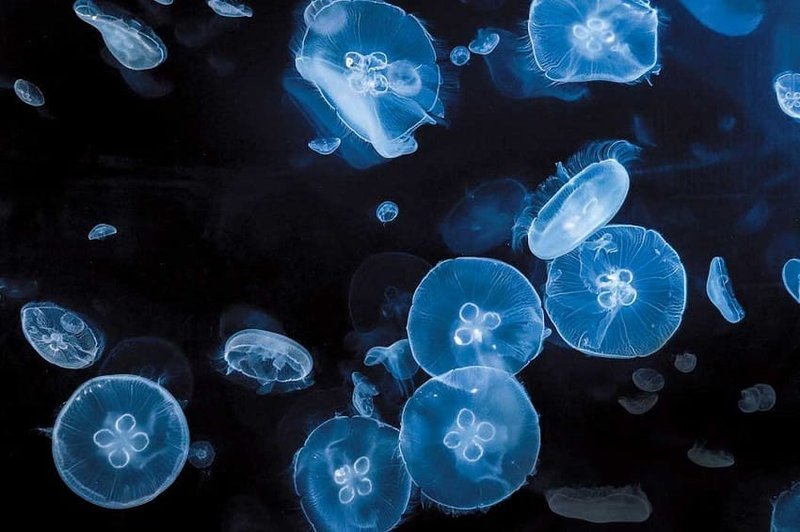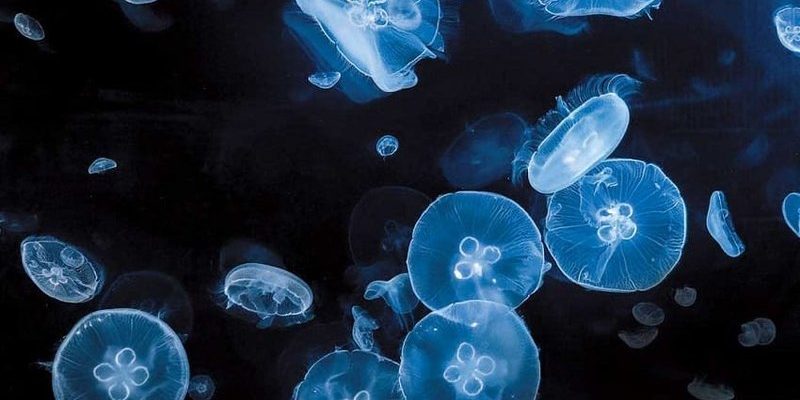
Imagine being in a crowded city without a map, relying solely on your instincts to get around. That’s kind of what the Moon jellyfish does! They have developed unique methods to navigate their environment and communicate with other jellyfish, all while being at the mercy of ocean currents. Let’s dive deeper to explore how these mesmerizing creatures manage such remarkable feats.
The Anatomy of Moon Jellyfish
To understand how the Moon jellyfish navigates and communicates, we need to start with its anatomy. This creature isn’t just a blob floating around; it has some amazing features that help it survive.
First, let’s talk about the bell-shaped umbrella that makes up most of its body. This bell, which can reach up to 16 inches in diameter, pulsates rhythmically to propel the jellyfish through the water. Imagine a balloon slowly deflating and inflating; that’s how the jellyfish moves! As it contracts, it pushes water behind it, allowing it to glide gracefully forward.
Next, we have the tentacles. While they might look delicate, these feathery appendages are lined with specialized cells called nematocysts. These cells can sting and are used for capturing prey and defending against predators. The tentacles also play a role in sensing the environment, helping the jellyfish navigate its surroundings.
Navigating the Ocean: How Do They Do It?
You might be wondering, without a brain or eyes, how does a Moon jellyfish navigate the vast and often turbulent ocean? The secret lies in their ability to sense their environment using various mechanisms.
First, Moon jellyfish utilize light sensitivity. They have specialized cells in their skin that can detect light and dark, allowing them to swim closer to the surface during the day and deeper at night. This behavior keeps them safe from predators while optimizing their hunting for plankton and other small organisms.
Additionally, these jellyfish can respond to ocean currents. By adjusting the rhythm of their pulsations, they can move with the currents or even against them to reach their destination. It’s like surfing—with a bit of jelly-like grace! This ability to harness external forces helps them travel long distances without expending too much energy.
Communication in the Deep Blue Sea
Now, let’s shift gears and talk about communication. How do Moon jellyfish interact with each other in the open water? While they don’t have voices or sounds, they do communicate in other intriguing ways.
One primary method is through chemical signals. Jellyfish release various substances into the water that can be picked up by other jellyfish. These chemicals can signal things like readiness to breed or warnings about nearby danger. This is a bit like sending a text message—without a smartphone!
Another fascinating aspect of their communication involves movement and pulsation patterns. Researchers have noticed that jellyfish can change their swimming patterns in the presence of others. It’s as if they’re sending out non-verbal cues, telling other jellyfish where to go or what to do. Imagine a dance party where everyone syncs their moves without saying a word!
The Role of Environment in Navigation and Communication
The environment plays a huge role in how Moon jellyfish navigate and communicate. Factors like water temperature, salinity, and current strength can all influence their behavior.
For instance, Moon jellyfish thrive in warmer waters, often found in coastal areas. In these regions, they can take advantage of the nutrient-rich waters that support their diet. Changes in temperature or storm events can alter their swimming behaviors, pushing them to seek calmer areas or more food sources.
Additionally, jellyfish often aggregate in large groups, especially during breeding seasons. This communal living can enhance their communication, as the chemical signals and movements become more prominent in a crowded space. It’s like a bustling café where everyone shares their conversations more freely!
Why Understanding Jellyfish Matters
So, why should we care about how Moon jellyfish navigate and communicate? Well, these creatures play a crucial role in marine ecosystems. They serve as both predators and prey, supporting the balance of ocean life.
Moreover, studying jellyfish behavior can provide insights into broader environmental changes. For instance, if jellyfish populations increase due to rising ocean temperatures, it might indicate shifts in ecosystem health. By understanding their navigation and communication, scientists can better assess the impacts of climate change on marine environments.
Fun Facts About Moon Jellyfish
Before we wrap up, let’s take a look at a few fun facts about Moon jellyfish that show just how fascinating these creatures are!
- Stinging cells: Although they have stinging cells, their sting is usually harmless to humans.
- Bioluminescence: Moon jellyfish can glow in the dark, adding an enchanting touch to their underwater presence.
- Reproduction: They can reproduce both sexually and asexually, making them quite versatile.
- Longevity: While they might seem fragile, Moon jellyfish can live for several years in favorable conditions.
Closing Thoughts
Understanding how the Moon jellyfish navigates and communicates opens up a window into the mysterious ways of the ocean. These creatures, with their simple but effective methods, remind us of the complexity of life under the surface.
By learning about them, we gain insights not only into jellyfish behavior but also into the health of our oceans. So next time you see a jellyfish drifting by, take a moment to appreciate its journey through the deep blue, guided by instincts and ancient wisdom.

